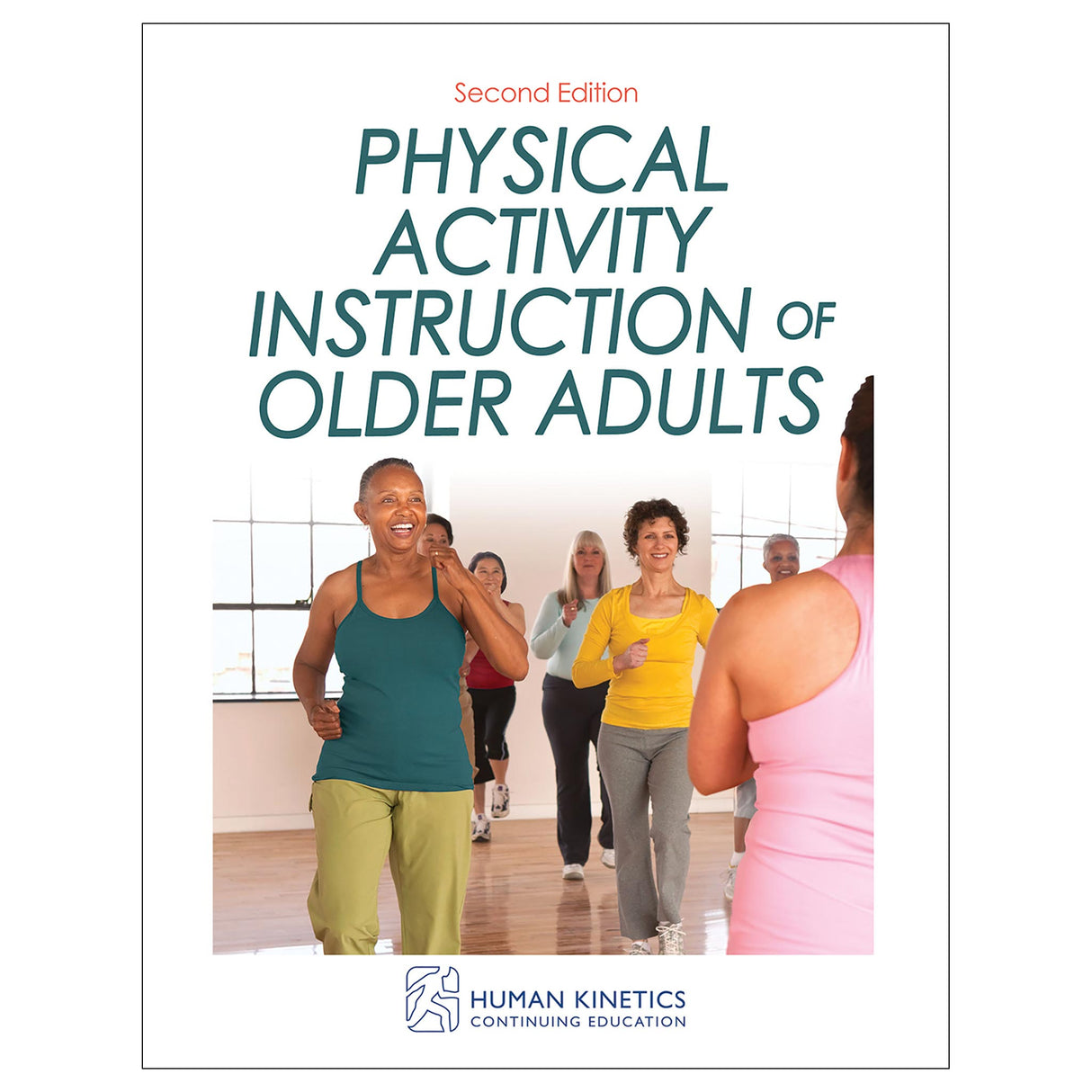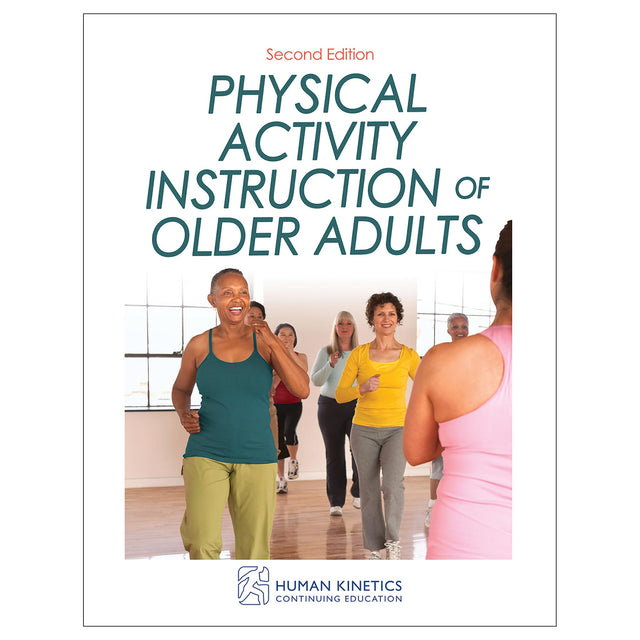Physical Activity Instruction of Older Adults 2nd Edition Online CE Exam With Ebook
Author: Human Kinetics
$181.95 CAD
Human Kinetics strongly recommends that you complete your exam within the calendar year of your date of purchase to ensure approved credits do not expire for your organization.
- Physical Activity Instruction of Older Adults, Second Edition, ebook
- Online continuing education exam
This cohesive blend of theory, practical content, and detailed instruction is divided into four parts, each of which addresses one or more of the nine training modules that comprise the expert-developed guidelines on which this text is based, International Curriculum Guidelines for Preparing Physical Activity Instructors of Older Adults.
Part I presents an overview of the physiological aspects of aging and the field of gerokinesiology to help you understand the psychosocial and cognitive benefits derived from regular physical activity. Part II leads you through the process of conducting preexercise health screenings and assessments, providing meaningful feedback to clients, evaluating program outcomes, and helping clients develop short- and long-term behavioral goals.
Part III emphasizes programming principles and training methods that will facilitate the development of well-rounded and effective exercise programs. It includes specific activities for engaging older adults mentally, emotionally, socially, and spiritually along with myriad dynamic and static flexibility exercises to address joint and muscle flexibility, muscle strength, balance, mobility, endurance, and power. Part IV focuses on the teaching, motivation, communication, and leadership skills that are necessary for creating effective and safe programs for older adults, with or without specific medical conditions.
Each chapter concludes with study questions and practical application activities that combine key concepts presented with real-world scenarios, preparing you to embrace a comprehensive wellness framework for designing well-rounded programs for older adults.
After reading the ebook, certified professionals can take the companion CE exam to earn continuing education credits.
Learning Objectives
- Describe the different components of aging and the impact of physical activity.
- Define successful aging and how the concept relates to the development of training programs.
- Explain the role of physical activity in the lives of older adults in general and with respect to chronic illnesses (e.g., physiological aspects related to aging).
- Design key aspects of a physical activity program for older adults with or without various common diseases.
- Describe the key aspects associated with screening, selecting, and evaluating assessment tools related to physical performance among older adults.
- Describe, develop, and implement individualized and group age-appropriate behavior change interventions and physical activity programs that affect older adults’ exercise participation.
- Explain the importance of critical aspects of physical activity programs, such as warm-up and cool-down exercises.
- Design, manipulate, apply, and evaluate program designs to accommodate the needs and training goals of older adults (e.g., resistance training, aerobic training, balance).
- Develop and apply teaching and leadership styles to facilitate evidence-based approaches and recommend physical activity techniques for older adults.
- Discuss and comply with ethical guidelines for personal trainers and group instructors.
Audience
Personal trainers, strength and conditioning coaches, and other certified fitness professionals.Chapter 1. The Field of Gerokinesiology
Debra J. Rose and Dawn A. Skelton
Demographics of Older Adults
Benefits of Physical Activity
Defining Old Age
Gerokinesiology: An Expanding Field of Study
Curriculum Development
Later Life Training Curricula: The Gold Standard for Instructor Training?
Career Opportunities
Summary
Key Terms
Recommended Reading
Study Questions
Application Activities
Chapter 2. Predictors of Successful Aging
Debra J. Rose
Biological Theories of Aging
Psychological Theories of Aging
Sociological Theories of Aging
Models of Successful Aging
Physical Activity as a Determinant of Successful Aging
Summary
Key Terms
Recommended Reading
Study Questions
Application Activities
Chapter 3. Psychological and Sociocultural Aspects of Physical Activity for Older Adults
Kathleen S. Wilson
Aging Stereotypes
Psychosocial Benefits of Physical Activity
Promoting Physical Activity
Summary
Key Terms
Recommended Reading
Study Questions
Application Activities
Chapter 4. Physiological Aspects of Aging
Priscilla G. MacRae
Cardiovascular Function
Respiratory Function
Muscle Function
Skeletal Function
Nervous System Function
Summary
Key Terms
Recommended Reading
Study Questions
Application Activities
Part II. Screening, Assessment, and Goal Setting
Chapter 5. Preexercise and Health Screening
Debra J. Rose
Preexercise Screening
Screening Steps
Additional Screening Tools
Implications for Program Design and Management
Summary
Key Terms
Recommended Reading
Study Questions
Application Activities
Chapter 6. Physical and Functional Assessments
C. Jessie Jones and Roberta E. Rikli
Functional Fitness Framework
Considerations for Test Selection and Evaluation
Recommended Assessment Tools
Guidelines for Group Physical Performance Testing
Interpreting Test Results
Summary
Key Terms
Recommended Reading
Study Questions
Application Activities
Chapter 7. Goal Setting and Behavioral Management
Sara Wilcox and Abby C. King
Factors Influencing Older Adults’ Exercise Participation
Theoretical Frameworks for Behavior Change
Physically Active Lifestyles
Implications for Program Design and Management
Summary
Key Terms
Recommended Reading
Study Questions
Application Activities
Part III. Core Program Principles and Training Methods
Chapter 8. Important Considerations When Designing Exercise Programs for Older Adults
Debra J. Rose
Heterogeneity of Older Adults
Optimizing Physical Function Through Exercise
Exercise Principles for Program Design
Specific Exercise Principles for Older Adults
Summary
Key Terms
Recommended Reading
Study Questions
Application Activities
Chapter 9. Whole-Person Wellness for Successful Aging
Janis M. Montague, Debra J. Rose, and Judy Aprile
Wellness: A Change in Perspective and Perception
Defining Wellness: A Historical Perspective
Whole-Person Wellness: A Comprehensive Perspective
Whole-Person Wellness and Successful Aging: A Winning Combination
Defining the Dimensions of Wellness
Applying the Dimensions of Wellness
Summary
Key Terms
Recommended Reading
Study Questions
Application Activities
Chapter 10. Principles of the Warm-Up and Cool-Down
Mary Ann Kluge
Warming Up
Goal Setting
Assessing Participant Readiness
Increasing the Challenge
Engaging Participants Socially and Emotionally
New Warm-Up Strategies
Cooling Down
Summary
Key Terms
Recommended Reading
Study Questions
Application Activities
Chapter 11. Flexibility Training
Debra J. Rose
Age-Associated Changes in Flexibility
Types of Stretching Techniques
Incorporating Flexibility Training Into the Exercise Program
Examples of Flexibility Exercises
Summary
Key Terms
Recommended Reading
Study Questions
Application Activities
Chapter 12. Resistance Training
Joseph Signorile
Benefits of Resistance Training
Principles of Resistance Training
Training Variables
Resistance Training Conditions and Modalities
Resistance Training for Older Adults
Summary
Key Terms
Recommended Reading
Study Questions
Application Activities
Chapter 13. Aerobic Endurance Training
Susie Dinan-Young and Dawn A. Skelton
Benefits of Aerobic Endurance Training for Older Adults
Principles and Considerations for Aerobic Endurance Training
Variables for Aerobic Endurance Training
Training Precautions and Considerations
Implications for Program Design and Management
Summary
Key Terms
Recommended Reading
Study Questions
Application Activities
Chapter 14. Balance and Mobility Training
Debra J. Rose
Age-Associated Changes in Balance and Mobility
Balance and Mobility Exercises
Manipulating the Challenge in a Group Setting
Summary
Key Terms
Recommended Reading
Study Questions
Application Activities
Part IV. Program Design, Leadership, and Risk Management
Chapter 15. Applying Movement Analysis and Motor Learning Principles to Program Design
Debra J. Rose
Nervous and Musculoskeletal System Changes and Motor Skill Learning
Movement Analysis of Skills
Motor Learning Principles for the Physical Activity Instructor
Summary
Key Terms
Recommended Reading
Study Questions
Application Activities
Chapter 16. Teaching and Leadership Skills
Helen Hawley-Hague and Susie Dinan-Young
Developing Your Leadership Style
Developing Your Instructional Methods, Techniques, and Strategies
Advancing Your Instructional Skills and Strategies
Developing Your Leadership Skills
Summary
Key Terms
Recommended Reading
Study Questions
Application Activities
Chapter 17. Exercise Considerations for Medical Conditions
Matthew J. Peterson
Cardiovascular Conditions
Pulmonary Disorders
Diabetes
Musculoskeletal Conditions
Neurological and Cognitive Conditions
Summary
Key Terms
Recommended Reading
Study Questions
Application Activities
Chapter 18. Legal Standards, Risk Management, and Professional Ethics
Debra J. Rose
The Law and the Physical Activity Instructor
Risk Management Plans
Ethical Guidelines for the Physical Activity Instructor
Summary
Key Terms
Recommended Reading
Study Questions
Application Activities
Appendix A. International Curriculum Guidelines for Preparing Physical Activity Instructors of Older Adults
Appendix B. IDEA Code of Ethics for Personal Trainers
Appendix C. IDEA Code of Ethics for Group Fitness Instructors





